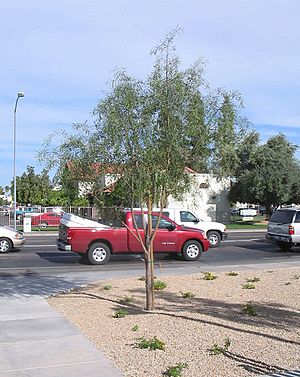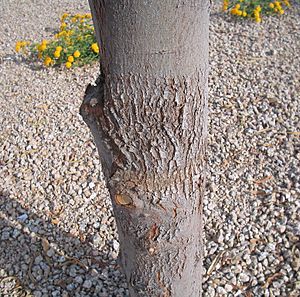Acacia salicina facts for kids
Quick facts for kids Acacia salicina |
|
|---|---|
 |
|
| Scientific classification | |
| Genus: |
Acacia
|
| Species: |
salicina
|
 |
|
| Occurrence data from AVH | |
| Synonyms | |
Acacia salicina is a type of Acacia tree. It does not have thorns. This tree is originally from Australia.
People call it by many names. Some common names are cooba, native willow, willow wattle, Broughton willow, Sally wattle, and black wattle.
This plant can be a large shrub or a small evergreen tree. It usually grows between 3 and 20 meters (10 to 65 feet) tall. An Acacia salicina tree can live for about 10 to 50 years. In the Northern Hemisphere, its flowers usually appear from October to January. You can often see its seed pods from April to July. The seeds are shiny and black. They have a bright crimson (red) part called an aril. Acacia salicina is very similar to Acacia ligulata and Acacia bivenosa.
Contents
Where it Grows
Acacia salicina is found in parts of Eastern Australia. It grows in areas that get different amounts of rain. Some places get a lot of rain, like northern Queensland. Other places, like central Australia, get very little.
This tree grows well in full sunlight. It can also handle cold weather. It can survive frosts down to about -6.7 degrees Celsius (20 degrees Fahrenheit). You can find it growing from 50 to 300 meters (164 to 984 feet) above sea level.
How People Use Acacia salicina
Stopping Erosion
Acacia salicina trees can help keep soil in place. They are useful for stabilizing riverbanks. They also help in other areas where soil might wash away.
Food for Animals
The leaves and seed pods of this tree are important food for livestock. This is especially true during dry times. The tree can survive droughts very well. However, its leaves and pods are not as easy for animals to digest as some other plants. This means animals get less nutrition from them. In 1889, a book called 'The Useful Native Plants of Australia’ noted this. It said that animals liked to eat the leaves. It also mentioned that the tree was becoming rare because animals ate it so much.
Human Food
The seeds of Acacia salicina are safe for people to eat.
Landscaping
This tree is great for landscaping in dry places. It can make gardens and parks look nice. It also helps the environment in dry areas.
Tannin
The bark of the tree has a lot of tannin. Tannin is a natural substance. It is used in many industries, like making leather.
Wood
The wood from Acacia salicina is very hard. People use it to make beautiful furniture. In the past, this wood was also used to make axles for wagon wheels.
The wood burns well and makes good fuel. It produces a lot of heat when burned. The tree can grow quickly. It can produce seeds and wood for crafting in as little as five years after planting.
Other Uses
Indigenous Australians traditionally used the bark. They used it to help catch fish. The 1889 book 'The Useful Native Plants of Australia’ also listed common names for the tree. It was called "Native Willow" and "Broughton Willow" near the Broughton River in South Australia. Indigenous people in Western New South Wales called it "Cooba" or "Kooba". Those on the Castlereagh River in New South Wales called it "Motherumba".
Spreading as a Weed
Acacia salicina can spread very easily. Its seeds are carried widely. Also, individual trees can quickly form thick groups. They do this by growing new shoots from their root system. Because of this, the species has become a significant weed in some areas. This happens both where it naturally grows and where it has been introduced.
See also
 In Spanish: Acacia de hoja de sauce para niños
In Spanish: Acacia de hoja de sauce para niños




